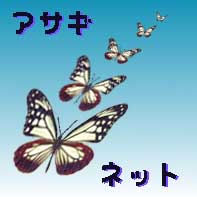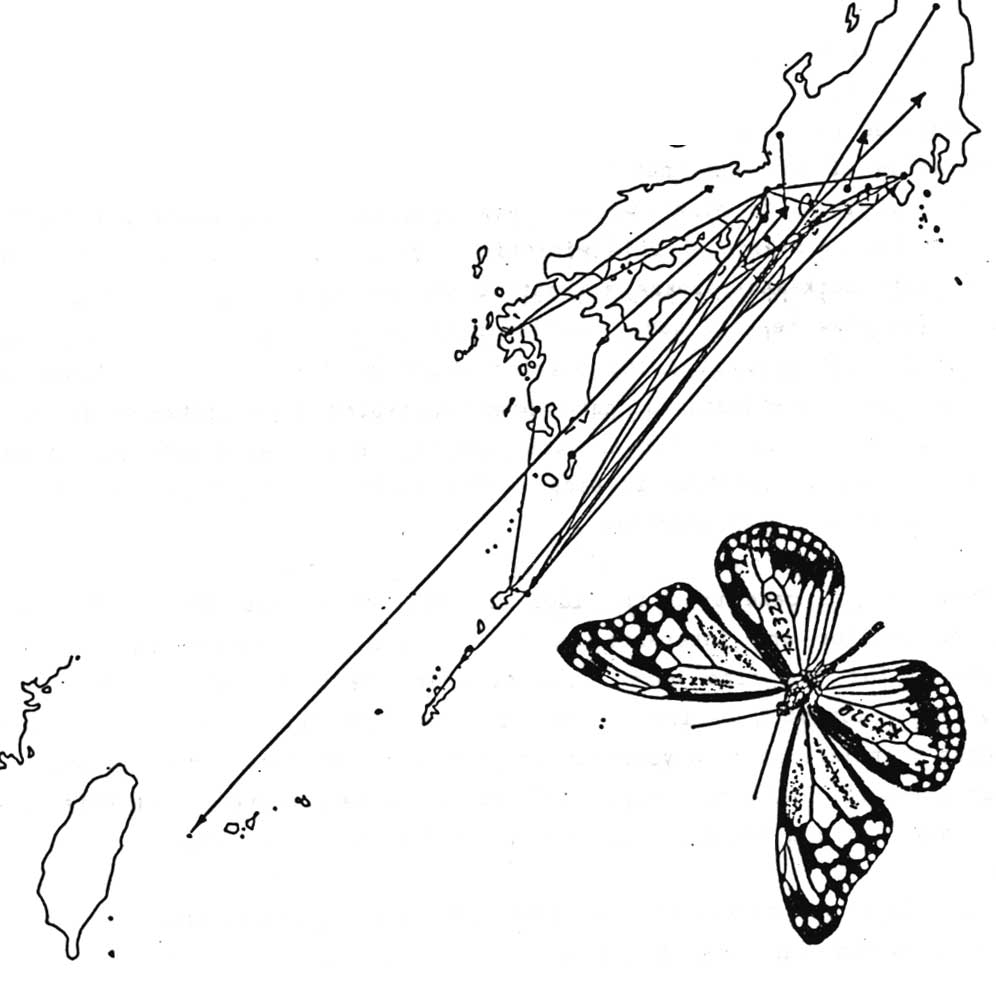





 The Chestnut Tiger Newsletter No.50
The Chestnut Tiger Newsletter No.50
 Fig. Confrmed case of travel within the Japanese Archipelago (1981-1996), and an example of a marked butterfly illustrated.
Fig. Confrmed case of travel within the Japanese Archipelago (1981-1996), and an example of a marked butterfly illustrated.
The mapped records iadicate records of northward migration are still very few.
The Chestnut Tiger moves northwards around April--June on the seasonal southwesterly wind. The new generation born around June--August in highlands or high lalitudes travels southwards around September--November, taking advantage of the seasonal northerly wind flow. The female lays eggs there in the south. This species overwinters mostly in the laraval stage, and new adeults emerge in the spring. This is their anuual cycle of life history. The confirmed migration range is at present confined within the Japanese Islands (see Figure). However, as one of the probable "ports of embakation" of the vernal nothward migration and also as one of the "ports of disembarkation" of the autumnal southward migration, Taiwan and the continent, in parlicular, are nobable. Furthermore, up to where they move north in East Asia and their migration along the continent are interesting, but not yet unsolved issue.
I made preliminary surveys along the coastline in northern Taiwan (Chinshan--shihmen, Yangmingshan) in the early June in 1994, and along the coastline in eastern Taiwan (Hualien, Juisui, Tachiangkou, and Kuangfu) in the early December in the same year. However, in both regions my survey periods seem to have been too late, and I obtained only some hints for future research. The following are points to be noted in mark-and-release of the Chestnet Tiger butterfly.
Mark signs and/or numbers on the wings with felt pen using oil-based ink, and then simply release the butterfly. For easy rediscovery of the marked butterfly even after considerable wear, marking on upper part of both left and right hindwings would be better (see Figure). For the signs and numbers to be marked, although there are no special rules, it is highly recommended that some hint for the site of release is included for the convenience of the recapture (e.g., "Taipei," "TAIWAN," "TAI," etc. to be included in the case of Taiwan). A record from file used in Japan lists; "sigh/symbol, number, date, place, sex, degree of wear, forewing length, ecology and other notes, etc." for each marked and released butterfly. in short, it suffices if the minimun information is retracable later with regard to when, where, and who marked and released the buttefly.
In the spring, release of butterflies would be desirable in the northern or eastern part in March-April. In lowlands the flower of Gynura bicolor (Compositae) planted as vegetables in human residential areas is one of the adult Chestnut Tiger's favorite, and attracts many which happen to pass nearby. This plant may be planted in school flower beds to check the passage of adult butterflies. In the case of Taiwan, this species may move in May-June up to the highlands such as Yangmingshan.
If marked and released in many places in East Asia, the realities of the migration will be grasped much better. If any attempt of mark-and-release of butterflies is made, it is desirable that someone gathers the information in eaeh region or country; also a report to our Research Group would be much appreciated so that we can call attention in Japan.
In the autumn, please pay attention to search for marked butterflies from Japan. The release season in Japan is August--October. Therefore, recapture outside Japan is expected the season thereafter. Hopeful sites of recapture are everywhere along the eastern or northern coast, whether continental or insular, and possibly some may be recaptured even somewhere inland. Autumn−flowering thistles Ageratum spp. (Compositae)and so on, which provide adults with nectar, and larval foodplant vines (Cynanchum liukiuence, Tylophora japonica, Hoya carnosa, Gymnema alteniforum, Marsdenia tinctoria, etc.; Asclepiadaceae) should be searched with a special attention.
In April-June in Japan, Parantica melaneus swinhoei is occasionally found together with the Chestnut Tiger (Parantica sita). Also numerous Tirumala limniace and a small number of closely related species fly over as well. Therefore, marking and releasing of these butterfly species also might give unexpectedly interesting results.
These days in Japan not only butterfly researchers and enthusiasts but also ordinary ladies, children, and retired people incresingly participate in the butterfly mark-and−release excursions; which is the new driving force to gain more information about the secret of nature. At the time of release, recapture seems to be only a dreamlike possibility. However, in reality the possibility has been proven to be better than a mere dream. Nay, even if it remains a dream, that is fine.
I hope dream-chasers like us will increase in East Asia.
Haruo FUKUDA (4-5-32 Meiwa, Kagoshima, 890 JAPAN)
福田 晴夫 (〒890 鹿児島市明和4−5−32)
Tel & Fax: 099-***-**** E−Mail:tefutefu@po.synapse.or.jp
(Translated from the Japanese by H. Takasaki at Okayama University of Science, Japan, using his translation assisting software package "Trex")
★ 原典は「アサギマダラ・ニュース」No.46(1997.2.22発行)
発行不定期、会費不要、投稿・情報歓迎。本紙の入手希望者は、封筒に80円切手を貼り、自分のアドレスを記入して送っておくこと。(切手だけでは困りますので、よろしく)
このページは、「アサギマダラ大移動研究会」発行のアサギマダラ・ニュースの内容を、インターネット版として掲載したものです。ただし、プライバシー保護のため、投稿者(情報提供者)の住所等は省略表示してあります。
このページは「アサギマダラ大移動研究会」の福田晴夫さんの全面的なご協力によって、作成したものです。この場を借りて、お礼申し上げます。
アサギマダラの移動に興味をもたれた方は、是非、マーキング調査に御参加下さい。簡単なやり方を覚えれば、誰でも参加できます。マーキングの仕方は、近日中にこのホームページで紹介する予定です。
なお、このページならびにアサギマダラに関するご質問、お問い合わせは 藤井 恒 または 福田晴夫さん までお願いします。